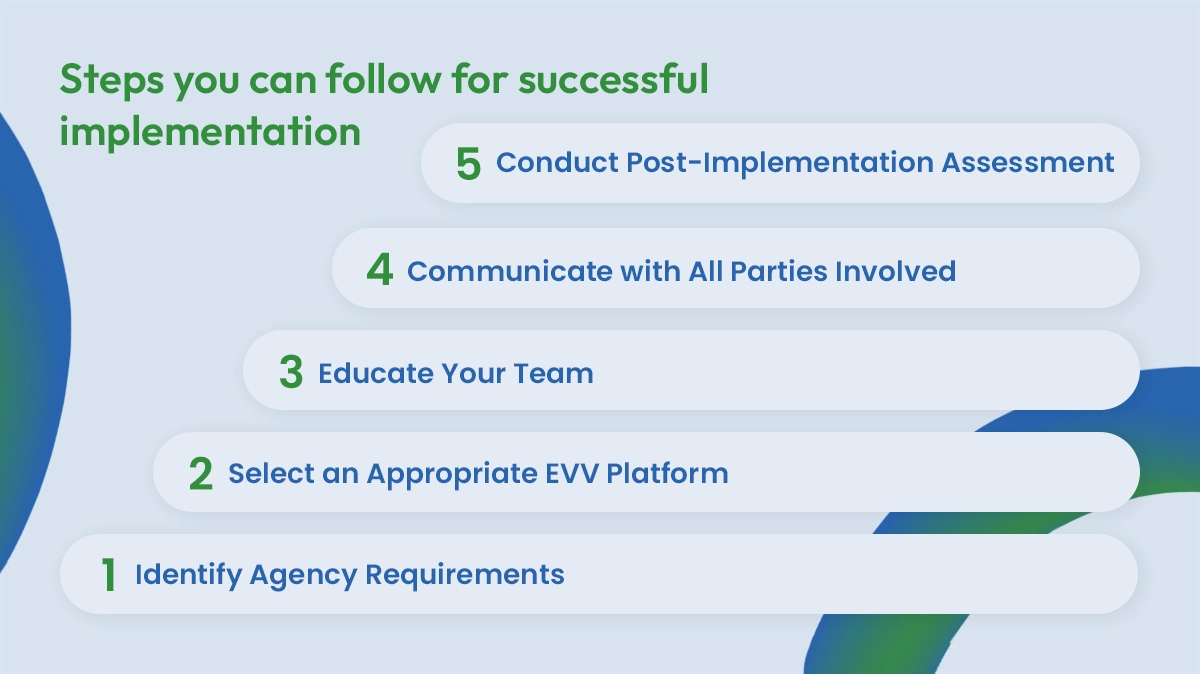🚀 We are finalizing all preparations to introduce you to the most powerful homecare software. Join the waitlist to witness something truly advanced in Summer 2025! Thank you for your interest.

See in real time what Jiris can do for you. Let the power of AI transform your agency
Get a DemoThe US Congress passed the 21st Century Cures Act in 2016 in response to reports of fraud in personal care services (PCS) and home health care services (HHCS). At that time, caregivers logged their visits manually. This method was difficult to verify and open to falsification.
With the Cures Act, agencies that provide in-home visits funded by Medicaid are mandated to use EVV in place of manual logs. This ensures their clients receive appropriate home health care services as scheduled and are billed accurately for it.
Across all states, the deadline for implementation was January 1, 2020 for Medicaid-funded PCS and January 1, 2023 for HHCS. Those that fail to enforce the Act risk the penalty of reduced Federal funding.
EVV stands for Electronic Visit Verification, a type of technology that guarantees home care agencies are delivering prompt and efficient services.
How does EVV work? It electronically validates and records the details of caregivers’ visits to in-home patients. These include the date and time of arrival and departure, location, type of service, and personal details of both the patient and the caregiver.
With this software, home care agencies can electronically monitor their caregivers’ activities. This reduces instances of fraud and errors. Also, home-based patients receive the specific care they need. There is also the potential for it to be at a higher level of quality.
The EVV system is essential for both parties: Caregivers and home care agencies can rely on it to bring more transparency and accountability to their field. Meanwhile, patients and members of their households gain peace of mind from the assurance that they are receiving the services stated in their billing statement.

There are multiple ways to satisfy the EVV requirement. Verification solutions can be implemented using various mechanisms, each leveraging different technologies to verify visits:
1. Telephony: Caregivers make a call from the patient’s home phone to confirm the start and end times of their visit. This approach uses the patient’s landline to verify the caregiver’s presence.
2. Mobile Applications: Smartphone apps with GPS capabilities allow caregivers to clock in and out, capturing the precise location and time of the service.
3. Biometric Devices: These use unique biological identifiers, such as fingerprints or voice recognition, to validate the caregiver’s entrance to a patient’s home. It adds an extra layer of security and accuracy.
4. Fixed Devices: Installed in the patient’s home, these gadgets require the caregiver’s interaction at the beginning and end of each visit to confirm their presence on-site.
Each of these systems has its own set of advantages, and a home care agency should choose one based on the specific requirements of their services and technological infrastructure.
Establishing an EVV system in your home care agency requires careful planning and execution.
You are likely to face some challenges when adopting EVV. Here are the difficulties faced by many home care agencies during the transition to EVV:
Addressing these challenges requires proper training, technical support, and clear communication with caregivers and stakeholders.
Here are steps you can follow for successful EVV implementation:

Analyze your agency's distinct needs, such as the number of staff, service types, and areas covered. Select the most effective EVV options based on available technologies and the preferences of your caregivers.
Choose an EVV system that seamlessly integrates with current tools like scheduling, billing, and payroll systems. Look for features that facilitate easy use by your staff. Also, verify that the platform meets all federal and state mandates. To find out how to Choose the best EVV system for home care and home health check out this EVV system selection guide.
Create an extensive training plan for both caregivers and office personnel. Offer practical training opportunities and develop guides or instructional videos. Ensure that everyone is able to navigate the new system.
Throughout the implementation process, explain to your staff, caregivers, clients, and their families the advantages of EVV in enhancing service quality and accountability. Expect resistance to learning and adjustment, and be prepared to address them.
Consistently review and analyze EVV data for precision and regulatory adherence. Use the gathered information to enhance service delivery and operational performance. Perform regular checks as well to detect and correct any issues. Establish a dedicated support line or assistance team that will provide ongoing help and resources for caregivers and administrative staff.
What does EVV stand for in healthcare provided by home care agencies?
Home care providers must follow federal regulations that mandate the use of EVV for Medicaid reimbursement. This is their guarantee that the services they deliver meet both industry standards and state requirements.
EVV significantly reduces the risk of fraudulent claims by validating that services are actually provided. It not only protects the integrity of home care agencies but also makes sure that resources are allocated correctly.
By confirming that services are delivered as planned, EVV enhances the quality of care that patients receive. Verifying that caregivers are present and performing their duties leads to better patient outcomes. Additionally, an advanced EVV solution can assist in improving caregiver retention rates.
These elements highlight why EVV is crucial in the home care industry: It helps maintain high standards and trust.

Automating the EVV process brings numerous advantages to agencies that significantly improve operational efficiency and service quality:
Incorporating these automated EVV features can profoundly and positively impact the day-to-day operations of home care agencies.
Compliance reviews of EVV Usage and EVV Landline Phone Verification by PCS and HHCS providers have started on January 1, 2025. Home care agencies benefit greatly from integrating EVV into their daily operations not only by ensuring compliance with both state and federal regulations. It also improves the quality of care they provide by enhancing accountability and transparency.
Jiris, an all-in-one home care software solution, offers essential tools that aid in the seamless integration of EVV. Through a digital records and coding module, Jiris simplifies the management of billing and scheduling.
With the Jiris EVV software, agencies get real-time updates on caregiver schedules, alerting them to no-shows, cancellations, or delays. This way, they can respond quickly and effectively to any changes. Agencies can also keep accurate records using Jiris digital tools to reduce the likelihood of errors.
Everyone who is already running or wants to start a home care business, should be aware that adopting EVV is a step towards better, more reliable care management. You can also expect minimized claim rejections and eliminate manual input errors to boost your agency's financial health.
AI assistant, smart shift assignment, and more. All-in-one solution for your home health agency. Our software expert will show you all features and how your organization can benefit from Jiris software.
Request your free live demo!Now it’s time to schedule your meeting
Schedule Now Need to fix your submission?Rate this article: